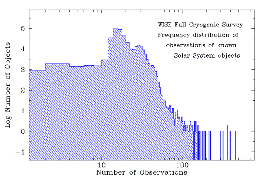 |
(Eq. 1) |



Association between WISE detections and known SSOs (solar-system objects) is performed by the SSOID module, which uses standard orbital elements based on MPC (Minor Planet Center) data to solve Kepler's equation for each SSO (except for planetary satellites, which are handled specially, as described below), identify which fall into the WISE field of view during the integration time of each frame, and search the list of WISE source detections for that frame to find associations.
The list of osculating orbital elements was generated for epochs of every 100 days. Processing of a given frame used the list closest in time to the observation epoch. The osculation epochs were MJD 55200, 55300, 55400, 55500, and 55600. These lists of orbital elements were generated after the release of the last circular from the Minor Planet Center before second-pass processing began. Thus the database includes orbits published up to and including the 2011 February 18 batch of Minor Planet Circulars and all Minor Planet Electronic Circulars issued from then through 2011 February 28. Each list contains 471893 objects consisting of the types shown below.
| Numbered Asteroids | 264248 |
| Unnumbered Asteroids | 204576 |
| Periodic Comets | 551 |
| Nonperiodic Comets or Comet Fragments | 2503 |
| Planets | 5 |
The list of state vectors for planetary satellites contains 165 objects for the planets shown below with the number of satellites for each.
| Mars | 2 |
| Jupiter | 62 |
| Saturn | 61 |
| Uranus | 27 |
| Neptune | 13 |
A preprocessor program was also written that identifies all SSOs falling into a full scan swath and generates a subset of the SSO list applicable to frames in that scan. Use of the subset list of orbital elements reduces the CPU time required for frame association by about a factor of 30. Processing the full list for each frame, however, was found to be so fast that this reduction was not judged worth the extra pipeline control code, and so the preprocessor was not used in production.
The numbered asteroids are complete, with the orbits generally taken from the Minor Planet Circulars. The orbit for (134340) Pluto was taken from the JPL ephemeris DE405. Because the code used to integrate the orbits to the various epochs includes Pluto as a perturber, the perturbed orbit for Pluto becomes corrupted in the process. It was easier to replace the corrupted orbit with one derived from DE405 than to alter the integration code to omit Pluto as a perturber.
The unnumbered asteroids are generally restricted to those objects with multi-opposition orbits, with the intent being to avoid those objects with large ephemeris uncertainties. Exceptions were made for non-main-belt objects, such as Centaurs and Kuiper belt objects, and particularly near-Earth objects, including all objects discovered by WMOPS during the first-pass processing. The orbit for 2008 TC3 was removed because the object ceased to exist following its collision with the Earth on 2008 October 7. The orbits are generally taken from the Minor Planet Circulars or the Minor Planet Electronic Circulars. There are almost certainly some cases of orbits initially published by the Minor Planet Center and thus included in the SSOID orbit database that have since been removed from the MPC orbit database following their recognition of an incorrect linkage, but have not been removed from the SSOID database. There are also almost certainly some cases of double solutions where only one (possibly the incorrect one) solution has been included in the orbit database.
The list of periodic comets is complete, with the orbits generally taken from the Minor Planet Circulars or the Catalog of Cometary Orbits. For purposes of distinguishing periodic from non-periodic cases, the old-style 200-year threshold was adopted rather than the MPC-style 80 year threshold. Orbits of non-periodic comets have been included extending back to the early part of the 1900s, along with a handful of famous cases from before that. Note that several SOHO comets have been identified as being periodic but have not been assigned catalog numbers by the Minor Planet Center and therefore are tallied above as being among the non-periodic comets. Although some of the proposed linkages have yet to be confirmed, there are five cases of SOHO comets having been seen at three separate perihelion passages, which could be considered sufficient evidence for periodicity. The orbits for the fragments of Shoemaker-Levy 9 were removed because they ceased to exist following their collisions with Jupiter in 1994. Other comet orbits were removed because of duplication with the orbits of objects among the asteroids.
The orbits of the planets were taken from DE405. The orbits for Mercury, Venus, and Earth were removed because their solar elongations are such that they could never be observed by WISE. As mentioned above, the orbit for Pluto was removed to avoid duplication with the one contained among the numbered asteroids.
Planetary satellite processing employs a list of state vectors (position and velocity) relative to the mean equator and equinox of J2000 provided for the following epochs, nearly coinciding with when the host planet passed through 90 deg solar elongation, which four of the planets did twice during the observational phase of the WISE mission:
| Mars | JD 2455313.5 = 2010 Apr 27 |
| Jupiter | JD 2455370.5 = 2010 Jun 23 |
| Jupiter | JD 2455546.5 = 2010 Dec 16 |
| Saturn | JD 2455360.5 = 2010 Jun 13 |
| Saturn | JD 2455568.5 = 2011 Jan 07 |
| Uranus | JD 2455368.5 = 2010 Jun 21 |
| Uranus | JD 2455548.5 = 2010 Dec 18 |
| Neptune | JD 2455335.5 = 2010 May 19 |
| Neptune | JD 2455518.5 = 2010 Nov 18 |
All state vectors were taken from the JPL Horizons service. The ephemeris code includes perturbations by only the Sun, thus the need for two sets of epochs, as perturbations by other satellites would lead to unacceptably large errors in the ephemerides in the six months between sightings of the four gas giant satellite systems.
For a given SSO (other than planetary satellites), standard osculating elements are used to solve Kepler's equation to obtain the position and velocity vectors in J2000. A second computation is performed to include the one-way light time correction based on the distance from the spacecraft to the SSO. This and the topocentric corrections are computed using the sun-to-spacecraft vector contained in the FITS header of the WISE frame being processed. The header also contains the J2000 spacecraft velocity vector, which is used with the SSO velocity to compute proper motion and line of variation. The latter defines the major axis of the SSO position uncertainty ellipse. The major axis of that ellipse is computed from the orbital element uncertainty parameter and the ratio of the topocentric distance to the heliocentric distance, plus one arcsecond. The minor axis of the uncertainty ellipse is always taken to be one arcsecond. The ellipse axes and orientation on the sky of the line of variation allow the computation of a position error covariance matrix. The apparent position and this error covariance matrix are mapped into the WISE frame coordinate system used for the WISE source detections. This is the U-Scan coordinate system described in the section on Scan/frame position reconstruction. Position will be denoted (X,Y), and the elements of the position error covariance matrix will be denoted VarX, VarY, and VarXY, where the last is the off-diagonal element.
Processing of planetary satellites involves a completely different solution for the apparent position, proper motion, and line of variation. Each objectís orbital position about its parent planet must be integrated from a known orbital state at a chronologically close epoch. The method used employs a 15th-order Gauss-Radau integrator as discussed by E. Everhart (Everhart, E., 1984, "An efficient integrator that uses Gauss-Radau spacings", Dynamics of Comets: Their Origin and Evolution, Proceedings of IAU Colloq. 83).
The WISE detections and the SSOs that fell into the field of view are stored in memory arrays. The WISE sources all have positions inside the array because that is where they were detected, but the SSOs may have positions anywhere on the sky, and so their radial distance from the array center is required to be less than or equal to the array hypotenuse, since the array is generally rotated relative to the U-Scan system. After the SSOs that may lie inside the array have been stored, a loop over all SSOs in memory is performed; for each SSO the following match processing done.
A loop over all WISE sources in memory is performed; for each WISE source, a position comparison to the SSO is made in U-scan coordinates. Subscripts “w” and “o” will be used to indicate WISE and SSO objects, respectively. First a coarse test is made:
 |
(Eq. 1) |
where Dmax defaults to 10 arcsec. SSO/WISE pairs passing this test proceed to the chi-square test:
 |
(Eq. 2) |
where χ2max is the position-match threshold; the default value is 16. This value for a 2-D chi-square random variable implies that 99.966% of all true matches should be accepted, i.e., 1 out of every 2981 true matches will be sacrificed in the attempt to avoid false matches.
If the match is acceptable, then match counts are incremented for both the SSO and the WISE source, and the following logic is executed, where "record" means to set pointers to each source in the other's data structure and to store the chi-square value in the SSO's data structure:
This is the same algorithm that was used by 2MASS. In unconfused cases, it provides correct associations. In confused cases, it does not attempt to unravel every possible association. For example, if SSO A has an acceptable match involving WISE source B, but WISE source B already has a better match to SSO C, no attempt to fall back to any previous match for SSO A is made, although an acceptable match may possibly be found when the remainder of the WISE sources are tested for it. Similarly, if SSO A has a better match to WISE source B than SSO C, then SSO C is disconnected from WISE source B and no search for a second choice for it is made. Only single-pass best-available-match associations are kept. The fact that confusion occurred is seen in the match count values. A matched SSO may have a match count greater than 1, and an unmatched SSO may have a match count greater than 0.
It can also happen that a WISE source has two acceptable matches to SSOs, loses its best match to another WISE source, and does not fall back to its second choice SSO.
One extra ingredient omitted from the recipe above to reduce the complexity of the description is as follows: any WISE source with a position uncertainty greater than a threshold (default 5 arcsec) on either axis is tagged as “penalized”, and its position error covariance matrix elements are set to 1% greater than the maximum with zero covariance. As Equation (2) shows, large position uncertainties enlarge the denominator of chi-square, which is appropriate in cases of normal variation in estimation accuracy. When many faint and/or deblended sources are included for the sake of completeness, however, a large fraction of the sources have unacceptably large position uncertainties and dominate the chi-square test unrealistically. When a matched source has been marked as penalized, its chi-square score is changed to χ2max plus an integer counter for the number of matches within threshold for the given SSO. For example, with a threshold of 16, if the first match is a penalized source, the match chi-square will be set to 17. If no other matches are found, this match is retained, and the value of 17 in the output file shows that this was a penalized match that was not overridden by an unpenalized source. In most cases, however, several other matches are available (i.e., the match is diagnosed as confused), and one of these usually involves an unpenalized source. This approach allows the fact of confusion to be tracked but prohibits the highly uncertain source from taking over. Testing has shown that this tends to promote matches with more plausible colors for solar-system objects.
After all SSOs have been processed for association with WISE sources, another loop over all SSOs is performed to verify that unmatched SSOs had positions inside the real band-frame area, which is generally rotated relative to the U-scan system. The association processing is performed in U-scan because it is the most convenient system for that purpose, but since it is aligned with the local RA and Dec directions, the test for whether an SSO might fall inside the array must use the hypotenuse of the actual array. An unmatched SSO should not be considered “missed” if it fell into a part of the U-scan area not overlapped by the rotated band-frame. So the positions of all unmatched SSOs are transformed to band-frame coordinates, and the X coordinate must lie between ColMin and ColMax (defaults 1, and 1016, respectively for W1), and the Y coordinate must lie between RowMin and RowMax (defaults 1, and 1016, respectively for W1). Only matched and truly “missed” SSOs are written to the output table file.
Missed SSOs are output with null values for WISE fields, with the exception of the WISE noise values, which are taken as the average over all WISE source noise values, unless there are no WISE sources in the field, in which case these too are null. Matched SSOs have their WISE parameters filled in from the associated WISE source record.
Approximately half of all SSO predictions result in an association, although many of these are actually due to background contamination, as discussed in the Cautionary Notes below. As mentioned above, when no association is made, averaged WISE noise values are inserted into the output record. The histogram in Figure 1 below shows the number of SSOs whose predicted position was observed N times vs. N.
 |
Out of a total of 472,058 objects, 86,656 were never predicted to be observed, about 18.4%. 66 objects were predicted to fall into the WISE field of view 100 times or more, with the highest number, 459, going to 2010 GW147, an object discovered by WISE.
Just as in the case of the 2MASS SSO processing, there is always a significant chance of association with background astrophysical sources, particularly at low galactic latitudes where the background star density is high. Preliminary analysis has shown that some false matches have definitely occurred for SSOs that are expected to be very faint but are matched with bright WISE sources with stellar colors. With over 563 million sources in the All-Sky Catalog, and given that a typical acceptance area for a match to an SSO is about 300 square arcsec, a simple Poisson model predicts a 27.1% chance that at least one inertial source will fall randomly into an SSO acceptance region. This will happen more frequently at low galactic latitudes, of course, and less frequently at high galactic latitudes. When the SSO is detected, it will usually be a better match to the prediction than a random inertial source, but given that about half of the objects in the orbit list are too faint to detect, a substantial number of false matches can be expected. The only way to avoid false matches at this stage in the processing is to make a large sacrifice in completeness. That is not commonly done in a processing chain that includes downstream filters designed to boost reliability, however, and it has not been done in this release.
Some typical indicators of a false match are various combinations of the following earmarks:


